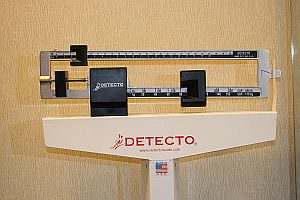How Much Money You Can Save From Losing Weight at Different Ages

Today we are sharing an article from Forbes magazine on how losing weight can save you money. Just ask our doc – Dr. Greg Oblander, losing weight saves you more than just money. Think that you are doomed to all of the health woes and diseases that have plagued your parents and grandparents? Would it surprise you to know that genetics only affect about 5% of health issues? Yup, it’s true. Our health is mainly determined by our health and lifestyle choices. Love that Big Mac? Well…it doesn’t love you! Today’s article cites a report that estimates that losing weight will save the average person at least $10,000 over a lifetime. We think that estimate is way low. (Think cost of cancer treatment, heart surgery, escalating medical costs). Money issues aside, how much is it worth to you to not have chronic pain, joint issues, arthritis, heart disease, diabetes, cancer…and the list goes on? Deciding now to get rid of extra weight and adopt the habit of exercise and eating real food will save you both health woes and money! An added bonus is that you will learn a greater degree of self-discipline! If you would like to change your lifestyle habits and/or lose weight, we can help! Call our Oblander Chiropractic office at 406-652-3553 and schedule your free consultation!
Please enjoy today’s article from Forbes magazine:
Losing weight can save you money over your lifetime.
Want another reason to lose weight? How about making your wallet heavier? In our study just published in the journal Obesity, we showed how much money that losing weight can save at any age, whether you are Millennial at 20 years old or a member of the Greatest Generation at 80 years old.
Five members of our Global Obesity Prevention Center (GOPC) at Johns Hopkins University (Saeideh Fallah-Fini, Atif Adam, Lawrence J. Cheskin, Sarah M. Bartsch and I) developed a computational model that simulated an adult at different starting ages and weights and calculated what could happen to the person’s weight, health and associated costs over time for the rest of his or her life. (Dr. Fallah-Fini is also an Assistant Professor of Engineering at the California State Polytechnic University.) Think of this model as a virtual person whom we can follow like a friend while the person ages.
For example, a simulated person could start as overweight at age 20 and then with each passing simulated year of the person’s life gain or lose weight and develop different types of chronic weight-related conditions such as diabetes, heart disease and cancer, just like a real person. The simulation would continue until the person died from either age-related causes or a weight-related condition such as having a fatal heart attack.
At the end of the simulation, we could then tabulate the amount of medical costs that occurred (e.g., hospitalizations and medications for stroke) and the amount of productivity losses that resulted (e.g., lost salary from being disabled or missing days of work for hospitalizations, clinic visits, falling ill or passing away early). By running the model with different starting weights (e.g., within the ideal body weight range) and then comparing the results, we could then see how medical costs and productivity losses may change with losing or gaining weight.
The model utilized data from a variety of sources such as the Coronary Artery Disease Risk Development in Young Adults (CARDIA) and Atherosclerosis Risk in Communities (ARIC) studies, the Framingham Heart Study (FRS), the Northern Manhattan Stroke cohort study, the National Cancer Institute database, the National Health Interview Survey, the Medical Expenditure Panel Survey (MEPS) and the Bureau of Labor Statistics. Dr. Adam played a major role in assembling and analyzing all of this data to help construct the model.
On average, going from obesity to normal weight, a 20-year-old could save a net present value of more than $28,000 throughout their lifetime, a 40-year-old more than $30,000, a 50-year-old more than $36,000, a 60-year-old more than $34,000, a 70-year-old more than $29,000 and an 80-year-old more than $16,000.
Going from overweight to an ideal weight range could save more than $10,000 at any age from 20 to 80, peaking at age 60 ($18,604). It may be that “love don’t cost a thing,” but obesity or being overweight certainly do.
In nearly all situations, at least half of these costs are from productivity losses (lost salary). In many cases, productivity losses constituted as high as nearly two-thirds of the costs. Since we used median wages, if you make much more, then losing weight could save you substantially more than the numbers we reported.
These numbers actually may be underestimates because the model focused on just a handful of major weight-related health conditions. We didn’t account for costs associated with a number of other weight-related issues such as joint problems and mental health issues such as anxiety and depression.
Extra weight not only hits you in the gut, but potentially in the heart, the brain, the liver, the kidneys and other parts of the body, and also the wallet.
And since we are all connected with each other via taxes (assuming that you pay taxes), insurance premiums (assuming that you pay for insurance) and the economy (assuming that you are a person and not a wombat), extra weight for someone else also may end up hitting your wallet, too.
Today’s article is shared from the following website: https://www.forbes.com/sites/brucelee/2017/09/27/how-much-money-you-can-save-from-losing-weight-at-different-ages/#7a2e40295c2a
 We talk a lot about the importance of reaching a goal weight and how to stay motivated. Sometimes, though, it still seems like a laborious task. If you’re carrying extra weight, you probably already know there are a myriad of health-related reasons to slim down. While it may seem impossible, little steps will carry you bit by bit down your weight loss path to your ultimate goal.While keeping your eyes on the big prize, it may help you to realize that even small changes in your weight may improve blood sugar, blood pressure, heart health, reduce cholesterol, and decrease your chances of developing diabetes. We’ve shared many motivational tips, but did you know that when you lose 10% of your bodyweight, you are instantly healthier? There’s no doubt that dropping weight will make you look and feel better, but there are numerous other benefts that you can realize while on your weight loss journey, which have nothing to do with how you look in your skinny jeans. Read more: Strategies for successful maintenance after weight loss.
We talk a lot about the importance of reaching a goal weight and how to stay motivated. Sometimes, though, it still seems like a laborious task. If you’re carrying extra weight, you probably already know there are a myriad of health-related reasons to slim down. While it may seem impossible, little steps will carry you bit by bit down your weight loss path to your ultimate goal.While keeping your eyes on the big prize, it may help you to realize that even small changes in your weight may improve blood sugar, blood pressure, heart health, reduce cholesterol, and decrease your chances of developing diabetes. We’ve shared many motivational tips, but did you know that when you lose 10% of your bodyweight, you are instantly healthier? There’s no doubt that dropping weight will make you look and feel better, but there are numerous other benefts that you can realize while on your weight loss journey, which have nothing to do with how you look in your skinny jeans. Read more: Strategies for successful maintenance after weight loss. Extreme Makeover features a celebrity trainer helping very overweight individuals reach their weight loss goals. Sometimes, their attitudes aren’t great, but other times, the people on the show are truly amazing, like Sara. Sara is a little person, standing at only 4’5″. She was a nutrition speaker on local television shows at the start of her journey, but ashamed of herself. Not only had she spent her life dealing with her short stature, but she had suffered greatly at the hands of her sister. She turned to eating and by the time she was 37 years old, weighed over 200 pounds.
Extreme Makeover features a celebrity trainer helping very overweight individuals reach their weight loss goals. Sometimes, their attitudes aren’t great, but other times, the people on the show are truly amazing, like Sara. Sara is a little person, standing at only 4’5″. She was a nutrition speaker on local television shows at the start of her journey, but ashamed of herself. Not only had she spent her life dealing with her short stature, but she had suffered greatly at the hands of her sister. She turned to eating and by the time she was 37 years old, weighed over 200 pounds.
 We talk a lot about how to stay motivated and the importance of reaching a goal weight. Yet sometimes, it still seems like a laborious task. If you’re carrying extra weight, you probably already know there are a myriad health-related reasons to slim down. While it may seem impossible, little steps will carry you bit by bit down your weight loss path to your ultimate goal on the Doctor Supervised ChiroThin Weight Loss Program™.
We talk a lot about how to stay motivated and the importance of reaching a goal weight. Yet sometimes, it still seems like a laborious task. If you’re carrying extra weight, you probably already know there are a myriad health-related reasons to slim down. While it may seem impossible, little steps will carry you bit by bit down your weight loss path to your ultimate goal on the Doctor Supervised ChiroThin Weight Loss Program™.
 Do you want to become healthier and stay healthy longer? Take a walk. That is the message of two important new studies.
Do you want to become healthier and stay healthy longer? Take a walk. That is the message of two important new studies.
 It almost seems like a silly question, but it’s worth answering nonetheless. Why? Because it’s too important not to—a great many people could avoid the potentially serious health problems associated with being overweight or obese by losing the extra pounds. And the sooner the better.
It almost seems like a silly question, but it’s worth answering nonetheless. Why? Because it’s too important not to—a great many people could avoid the potentially serious health problems associated with being overweight or obese by losing the extra pounds. And the sooner the better.
